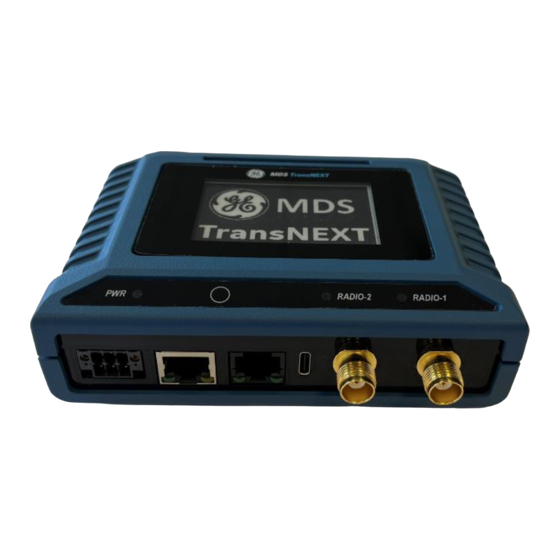
Advertisement
Quick Links
GE Renewable Energy
GE MDS LLC
1.0 INTRODUCTION
The transceiver, shown in
designed for license-free operation. These units employ Digital
Signal Processing (DSP) technology to provide highly-reliable
long-distance communications, even in the presence of weak
signals or interference.
The transceiver is housed in a compact and rugged die-cast
enclosure that need only be protected from direct exposure to
the weather. It contains a single printed circuit board with all
necessary components for radio operation. No jumper settings
or manual adjustments are required to configure the radio for
operation.
Figure 1. GE MDS TransNEXT Transceiver. Dual transceiver
version (left) and single transceiver (right).
About This Guide
This guide covers the GE TransNext operating in Transnet
Compatible Mode. All GE MDS manuals are available free of
charge at www.gemds.com.
Transceiver Features
Listed below are several key features of the transceiver. These
are designed to ease the installation and configuration of the
radio, while retaining the ability to make changes in the future.
•
902–928 MHz operation using the TransNEXT 900
•
User-selectable option to skip sub-bands with
constant interference
•
65,000 available network addresses
•
Network-wide configuration from the Master station
eliminates most trips to Remote sites
•
Data transparency ensures compatibility with virtually
all asynchronous SCADA system RTUs
•
Peak-hold RSSI averaged over eight hop cycles
•
Operation at up to 115,200 bps continuous data flow
•
Store-and-Forward repeater operation
•
Data latency typically less than 10 ms
•
Same hardware for Master or Remote configuration
•
Supports RS/EIA-232 and RS/EIA-485 user interface
Figure
1, is a spread spectrum radio
GE MDS TransNEXT
05-7267A01 REV 04. Quick Start Guide
•
Low current consumption; less than 3 mA in "sleep"
mode
NOTE: Some radio features may not be available on all
models. Features may be limited by the options purchased or
the applicable regulatory constraints for the region in which the
radio will operate.
Typical Applications
Multiple Address Systems (MAS)
This is the most common application of the transceiver. It
consists of a central control station (Master) and two or more
associated Remote units, as shown in Figure 2. An MAS
network provides communications between a central host
computer and remote terminal units (RTUs) or other data
collection devices. The operation of the radio system is
transparent to the computer equipment. When used in this
application, the transceiver provides an excellent alternative to
traditional (licensed) MAS radio systems.
Figure 2. Typical MAS Network
Point-to-Point System
A point-to-point configuration (Figure 3) is a simple
arrangement consisting of just two radios—a Master and a
Remote. This provides a half-duplex communications link for
the transfer of data between two locations.
Figure 3. Typical Point-to-Point Link
Adding a Tail-End Link to an Existing Network
A tail-end link can be used to extend the range of a traditional
(licensed) MAS system. This might be required if an outlying
site is blocked from the MAS Master station by a natural or
man-made obstruction. In this arrangement, a TransNEXT
Advertisement

Summary of Contents for GE MDS TransNEXT
- Page 1 Figure 1. GE MDS TransNEXT Transceiver. Dual transceiver version (left) and single transceiver (right). About This Guide This guide covers the GE TransNext operating in Transnet Compatible Mode. All GE MDS manuals are available free of Figure 2. Typical MAS Network charge at www.gemds.com. Point-to-Point System...
-
Page 2: Installation
Antenna Figure 5. TransNEXT Repeater Network Port Ethernet Accessories GE MDS offers an Accessories Selection Guide listing additional items that may be used with our products. Contact your factory representative or visit www.GEmds.com for the latest copy. Invisipbllhaeoc led er Primary 2.0 INSTALLATION... -
Page 3: Radio Programming
TX and RX time Figure 8: Top Panel display of initialized unit per channel in the hop sequence. In a normally operating system, you will see the GE radio skip <1,2,3,4> Set hopping channel MDS and TransNEXT screen as shown in Figure 8, zones to skip. -
Page 4: Troubleshooting
GE Renewable Energy GE MDS TransNEXT GE MDS LLC 05-7267A01 REV 04. Quick Start Guide 4.0 TROUBLESHOOTING All radios in the network must meet the following requirements for proper operation. Check these items first when troubleshooting a communication problem: • Adequate and stable primary power •... - Page 5 Installation professionnelle requise. L'équipement radio décrit Technical Assistance dans ce guide émet de l'énergie radiofréquence. Bien que le Factory technical assistance is available by contacting GE niveau de puissance soit faible, l'énergie concentrée d'une MDS during business hours (8:30 AM to 6:00 PM Eastern antenne directionnelle peut présenter un danger pour la santé.
- Page 6 GE MDS TransNEXT GE MDS TransNEXT Lite comply with Part 15 of FCC Rules. Operation is subject to the following two conditions: (1) This device may not cause harmful interference, and...















